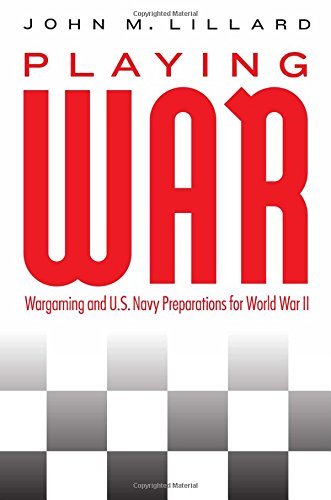Playing War: Wargaming and U.S. Navy Preparations for World War II
John M. Lillard
 John M. Lillard’s study of war games, aptly titled Playing War: Wargaming and U.S. Navy Preparations for World War II, dissects the players, game processes, and phases of wargaming during the interwar period. Wargaming proved to be a useful tool for the United States Navy in preparing for the naval battles of World War II. The wargames gave the Navy an upper hand, because they could predict movements of enemy ships based on the aforementioned games. In his attempt to prove if the war games and the Naval College had any historical agency, he delves into a previously under-explored topic. To prove his thesis, Lillard examines the impact of individual games and their players on the war effort, while also assessing the overall effects of wargaming through the inter-war period. Unlike historians such as Peter Perla and Michael Vlahos, Lillard reveals the significance of the war games to the development of technology and, ultimately, to the success of the United States Navy during World War II.
John M. Lillard’s study of war games, aptly titled Playing War: Wargaming and U.S. Navy Preparations for World War II, dissects the players, game processes, and phases of wargaming during the interwar period. Wargaming proved to be a useful tool for the United States Navy in preparing for the naval battles of World War II. The wargames gave the Navy an upper hand, because they could predict movements of enemy ships based on the aforementioned games. In his attempt to prove if the war games and the Naval College had any historical agency, he delves into a previously under-explored topic. To prove his thesis, Lillard examines the impact of individual games and their players on the war effort, while also assessing the overall effects of wargaming through the inter-war period. Unlike historians such as Peter Perla and Michael Vlahos, Lillard reveals the significance of the war games to the development of technology and, ultimately, to the success of the United States Navy during World War II.
Lillard first breaks down the Naval War College’s strategies and their assessments into sections. Using an assortment of charts, graphs, and images to support his thesis Lillard delivers the most in-depth study of war gaming to date. Through Lillard’s research, he found that war games were necessary to teach decision-making skills, as well as develop technology to advance the Navy. He uses speeches, diaries, and official records from the inter-war period as a primary basis for his argument. The downfall to Lillard’s sources is the focus on popular figures, such as Admiral Chester Nimitz, and the lack of voices from enlisted personnel. He does assess the data from the graduating classes, such as the number and type. He also shows the different fictional opponents throughout the wargames and provides graphics to aid in understanding for those without a military background.
At times, Lillard’s argument seemed long-winded. The lack of representation by other scholars in reference to the war games could be because the argument can be summed up within a few pages. But, Lillard was able to redeem his work by providing stories that piqued the reader’s interest when facts became dull. His assessment of the early phase, from 1919 to 1927, is particularly interesting, especially when he delves into one of the later exercises in 1927. The class of 1927 worked through a game that focused on both land and sea objectives, with special situations thrown at them at every turn. The class had to adapt to changes given through the games, leading to further advancements in the games.
Because Lillard uses individual games, his monograph has a narrative quality, aiding the readability of his work. While this history would be more aptly used by a military historian, the narrative aspect and the clear visual aids allow anyone to enjoy Lillard’s book. He determines that the Naval War College deserves agency within the historical context of preparations for battle, which he sums up nicely in the conclusion. Playing War is a well-written, well-researched, and well-received monograph adding a new facet to military history and the study of naval advancements.
- Bethesda: Potomac Press, 2016
- 6-1/4” x 9-1/4”, hardcover, 210 pages
- Illustrations, tables, appendices, notes, bibliography, index. $39.95
- ISBN: 9781612347738
Reviewed by Courtney Webb, University of West Florida
